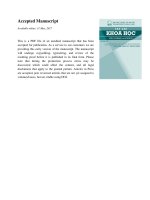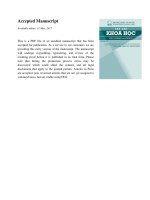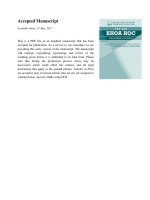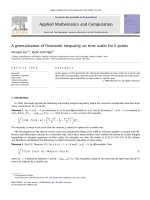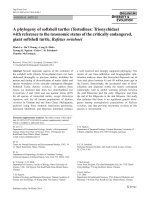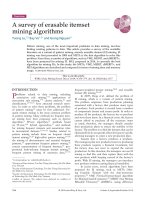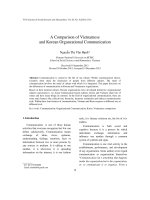DSpace at VNU: A Finite Algorithm for a Class of Nonlinear Optimization Problems
Bạn đang xem bản rút gọn của tài liệu. Xem và tải ngay bản đầy đủ của tài liệu tại đây (4.47 MB, 10 trang )
VNU JOURNAL OF SCIENCE, Nat
A F IN IT E
Sci
, t.xv.
n“ l - 1999
A L G O R IT H M
N O N L IN E A R
FOR
A CLASS
O P T IM IZ A T IO N
OF
PROBLEM S
V o V a n T iia ii D u n g
Hanoi University o f Technology
T ran Vu T h ie u
ỉhìiiui Iiistitritc o f Miitììeinntics
A b s t r a c t . In this paper a finite algonthm
IS
pvt sent ed for solving a class of nonhn-
Ẽữr optiniizatwii prohlevis with special slvuctuvf. It
IS
ha.'icd on 1}umbering IẼchĩììque s
to improve feasible solutions commonly used in sobnrig problems of travsportalion
type.
I. PR O B L E M STA TEM EN T
Given an w x n m atrix .4 =
p (0 < p < »)
where' a,, € {0, 1}, and given positive nuniboois
i = 1 ,2 ........in. Coiisidor the following optimi/sation pioblein:
ĨỈÌ
iP)
-rri — ^
max
Ĩ= 1
subject to
= /V ^ = 1 ,2 ........w.
int('g(TS, i = 1, 2, . . . . ĨII.
0 <
(2 )
J
= I .'2........ II.
(3 )
SilUT t h e o h j r c t i v o fviiictioii (1) is ro nvo x a m i till' c o n s t r a i n t s (2), (:ị) a r c liiiii'iu
and iiitegor, probloiii ( P ) is a Iioiiliiioai integer p i o g i a n u t i i i i g probU'in. H o w e v e r, as slicown
bolow, (P) may be mlucocl to a linc'ar inU'Rcr proi)l('ni with special stuK tuK '.
Th(' constraint (2) may also bo loplacod with iiioquality constraint (2‘) vvilluuiit
changing tho solution of (P):
> /'m ' = 1. 2,.
w.
(2'
;= 1
P r o b l e m ( P ) m a y 1)0 p x p l a i n r c l a s f o l l o w s : t h o l o a r e 111 s t i u l o n t s a i u l ÌI s u b j w t s i foi
t h o r n . Th(> I i u m b o r o f s i i h j o c t s I('qviir('(l f o r t l i P
tho a g m ' a b l e i i o s s o f stu(l('iit i t o s ub j ect I (a,
s t i u l e n t is p , . C o o f f i c i p i i f s (I, , I('p.r(' >s(' iit
I
= 1 if s t u d e n t Í is agn>eabl(' t o s iu h x jw t
/
and a,I = 0 if not). T he quostioii is how to a n a n g e the HtiulentH to learn fho s;iiiì)ị(Ị('( t-
A F'.ni.e A l g o r i t h m f o r a Class of..,
7
so thit ^acli oi stu dents li'ai'ii ('onipl(‘tf‘ly th(' ĩiiiniboi of suhjiTts roq u im l for liirn and so
th a t lu nunihi*r of st udents for each siihjoct is as similar as possihk'.
It is ('Hsily S(*(‘11 that (P) is ('quivaleiit to th(* following 0 - 1 intoger progranuning
probfnu
ÌÌ
ỈÌÌ
> />,, V/;
^ Vj: .7',^ G {(), 1},
7=1
< r/,^, V7,j}.
7-1
Tic model of probli'in (P) was studied ill [1] and [2]. In [2] the authors suggested a
polyionial time algorithm for problem (P) by solving a finite num ber of m axim um flow
probpin.'.
Eiploiting th r sprcial stnic'tiiip of thí' problrni, in the soquol we shall develop an
impnved algorithm for solving (P) which has the following features: (i) it is finite; (ii) it
is ba:ed on Iiuinborhig tociiniqui's to improve' feasible solutioiis coninioiily used ill solving
probiMn.’ of transportatioii type.
II. FOUNDATION OF T H E SO LU TIO N M E T P O D
Ai usually for the convniience \\v a g n v th a t a m atrix ./■ = {-Ỉ*;/} whoso entrios
satisv (2Ì and (3) is called a fcnsii)Ic soỉỉitioỉi of (P), a frasihle solution ac‘hi(‘\-iĩig the
mininuii of (1) is callod an opfiiiirii solution of (P).
L ( t VIS cl('iiot('
ỈÌI
lit
^
j = 1. 2........//,
p ^
/.= 1
(bị H pl
> 0.
/:=!
lit ^ I h e i i t u i i l n ' i u i ill l u h ' i i l ^ a ^ ỉ r f a i f l f t o Ml W jtH I y . H i n l p
1 l i e I lil h 1 l U i m b c i (.^1
subji ’ts irqiiii('(l for all stu(l(‘iits).
7)
; = 1,2....... iti.
, =
./-1
it is 110M'1 in [2] that in order to (P) has an optim al solution. A Iif‘('(‘ssarv and sufficii'iit
condtioi for the oxistoiKT of an optimal solution of (P) is
> Pi for all / = 1 ,2 ........ÌĨỈ.
(4)
Ccadition (4) is very simple and easily to be checked. So. we assum e th at (P) satisfies
this ondLon. Furtherm ore, without loss of generality ve may assum e th at the students
and sibjfcts are n um bered so th at
~ P\ ^ ^^2
— P2 ^ ■• • ầ.
“ Pnt find i n > h\ > h’2 ^
> hjt >
0.
Vo Van Tiian Dĩing, Tran Vu T h i e i u
8
It is Iiatiual to suppose that Ị)j > 0 for all ; = 1, 2,. . . » ÌỈ, hocauso if bj = 0 for soMifu'
; thou tho subject J must he deleted (there is no studoiit who wants to loarii the suhje<-t)).
For the sako of conve'iiieiK'r, for each f(’íusil>l(' solution .r wo c n ‘atp a tahlí' consist ÌMíip,
of ĨÌỈ rows and 71 columns, in which oach of rows (‘oriospoiuls to a student and c a c h oof
cohunns corrosponds to a subject. The cell lying at tho intersoction of row / and (olunu.n
J is (lonoted by
A feasible solution ./• — {-i'/j} of (P) will C'oirespoiul to a rabltk'
consisting of zeros and ones in its colls. A coll (?, j ) is called ỉ)ỈHck if a,Ị — 0 (blark celhls
will bo forbicldon to use, hocause studoiit i is not agreeable to suhjoct ý, HO that :i\i = ())).
The lem aining colls will bo divided into two classes; white cells if :r,y = 0 (stiulenr ? i is
agreeable to subject j , but ho is not allocated for this subject) and hliic cells if :r,, ~
1
(student / is allocated for subject j).
Denote
Vi
=
1.2,....n.
'5'))
7=1
- -
( f is the num ber of stu d en ts allocatod for siibjoct J and
is tho objectiv(' function valu'H'
of :r).
For any feasible solution .r
ĨÌ
;= 1
.;=1
of (P), according to (5) we liave
7Ì
-/
rn
Til
X__ J
a
Ì1Ì
Í.__ ề Í.__ ^
J = \ 1=1
Colum n J is called full if f
n
Í __ -
1=1 7= 1
n
d
,= l
(loficieiit if tj < t'' - 2. It should be iK)tot'(l
ĩhat the notions of blue coll, white cell, full column and deficient column arc c o n c fn io t’cl
with a given feasible solution.
The following proposition gives a simple criterion for an optim al solution of ( P ) .
P ro p o s itio n
1.
I f n foafíi/)/ọ R o /ijfio ij
=
tìieĩi r is
r
/jaK n o r i o / i r j n n f r i ) i i i i n n .
f- > f
~ u y j
i
o
.
(T7)
optiiiiHl soììition of (P).
Proof: From (6 ) and (7) it follows
p = '£f'',
-D -
m
Suppose the contrary that there oxists a foasihlo solution Ụ th at is Ix'ttoi til a n . T.
i.e.
t'j <
- 1, Vj - 1 ,2 ....,7 /,.
Combining (G) and (9) yiolds
.7-1
(Í9)
A F'.fiie A l g o r i t h m f o r a Class of...
9
whica s (’ontrarv to (8 ). Tims, .T is an optim al solution
□
} of (P). Let c ho a sequenrc of a ltm ia tin g
\)i)si(lci now a foa.sihlc soluf ion .r =
whit< aid !)hic cells wi th n'spoc't to .r Joiniiii’ roluniii Jo and coluniii JA- :
y o ) . ( ' o , . y i ( A - >
t = 0,1 , , , .
wher-
1)},
( 10)
are whitocplls ( .r „ „ = 0), while ( i i j i +i), f =
1, bluocclls (■(',, ,,^ | = 1). We iiứro(luc(' tho following tiansfoniiation of .r.
TrarỉS ioriĩiatioii A . On tho spqiK'iiro c. ipplaco all the forniPi' whit(‘ cells by blue oiiPS
a n d clltho foniior blur rolls by whitp ones. Thi s moans t h a t wo set
•'■^7, = 1-
=0, / =
1, rV = T , „ y o , j ) Ệ C .
"’ho following li'ninia sliows that this transforination does not change t h r objective
functoi value of .r.
L e m m i 1 . Assiiine tìiiìt r ' is uhtHÌned from r Ị)y Tiansfoiinatioii A oil sonic seqtience of
íììteriaiug w h ite a n d
i>iiie CCỈỈS j o i n i n g t w o c u l u i i i n s w h i c h a r e n o t f i d l . t h e n f ’’' =
/' ■.
Prooj niỊiposí' that thoLc ('xists a secuH'iice of fonii (10) joining two columns jo
< f'). Since ill oach of rows it {t = 0, I , k
whicl ;i(' not full
arc just two \vhir(> and hhu' cells of c.
.r' = {.r' J Katisfic's (2), (3),
- 1) there
i.e. r ' is also a feasible
in oacliof colunins J, {t = 1,2__________ Ả-
solutiji of (P). Siiiiihuly, since
Jh
- 1)
th e n ' are jilst
tw o v h f c a n d h h i c cells o f c . wo h a v e
vj^.yo,.yA-.
( 11)
( n tli(' otlu'i hand, as coliuuii Jd has only 01U' (('11 of c (wliito cell (/(J, ;q)), wc have
+ 1.
(19)
and a- (oluniii 7^. lias oiil\' one cell of c (l)lu(' coll {if,. 1, ii, )). W(' ftcf
Ik
Ỉ' Iiallv, HS c o l u n m s
Jo
S n i i l a i l v , S U P Ị) ( ) S ( ' t h a t
.Ik
-1 .
(13)
a n d ji, a i r not full, fr o m ( 1 1) - ( 13) it follows t l i a t f ' = f . □
c
is a c y c l e o f a l t t ' n i a t i n g w h i t e ' a n d b l u e c pl ls :
('o-Jo)^ ('o ..;i) ........i u ■Jk)A>k- Jo). {>0 , Ji)) (A- > 1).
w h o r e (/,./,),
/ =
0 , 1 ------ --
and (i,,/o) aro blue cclls
a r c w h i t r O 'lls
= .7',^
=
0), w h ile (/,,
), ^ =
0 , 1 , _____ Ẳ' -
1
= 1). Cunsiclpi' tlio followinp, tiaiisformatioii:
T r a n f f d - in a tio n B . On the cvcle c roplaro all the foinu'i white cells by blue onos and
all th( fiiiiioi' blue rf'lls 1)V wliito OIK'S. T h i s m e a n s th at \V(> set
■r' = .r „ , V ( K j ) ệ C .
Vo Van Tuan Dung, Tran Vu Th/.io.u
10
L e m m a 2. Sĩipposc tiicit r ' is uhtniiierl tioin r I)V TiiUisfuiiiintion B on ÍÌ cycle of HÌitoruHtiiig white and liluc cclls. then f
=
.
T h e r o w s a n d c o l u i u n s n u m b e r i n g . T h e p i o m l m e of rows aiul co lu m ns immlx-r iiiR
is dpfiiK'd as follows. First o f all, VVP assign 0 t o oach c o l u m n J wh ich is full (/;■ = f
). If
(‘o l u i u n j is imni'bri'pd, W(' a s s i g n i m in h f i' J t o o a c h r o w i w h i d i h a s n o t b e e n iim n h c 'H ’d
= 1 ( Ụ , j ) is a blue cell). Then, if row / is numbPied, wo assign minib.'i 7 to
aiul has
eac h colvmm
J
w h ic h h a s n o t b e e n lum iboiecl a n d h a s
a , I
-
T , J
=
1 ( th is is equivaloint to
a J = 1 .r,, = 0 i.('. (/ j ) is a white roll) and so on. T h e above piocediire must stop aiftor
a t m o s t 111 + V t i m e s o f r o w s a n d c o l i i n i i i s n u n i b o r i n g .
If a (leficiont column, o.g. column Jo with
< / ' - 2, is numbeipcl th(>io niusit he
a soquencp of a lto in atiag white and blue colls joining a somo full column and Jo- Sluch a
sequence of c<41s can be detonniiK'd as follows. Siipposo th a t column Jo with /
< /
- 2
is assigned witli nuiiiber ?0 (('o-Jo) is a white cell) and row IQ is assig n'd with umint)Pi
Ji Ỷ Jo ( ( ' o , J i ) is a blue cell). If c o l u m n Ji is a s s ig n e d w i t h n u m b r r not equa l t o ()„ for
instance, Ú # '0
is a white cell), and row /i is assigm'd with num ber J2 Ỷ J lo J i
( ( ' 1. j'i) is a blue con). If cohm m J2 is assigned with numbor not equal to 0, we confjinie
seairhiug. As tho uuinhei of columns ill the table is finite (oqual to 7/), finally w<' inmst
find out a column JA. ^
J ,
J = 0. Ỉ , .. . , k - 1. assigiH'd with num ber 0. i.o. JA-
a full
column and tho ro q u im l sequence is
c = {{ iq,J q), ( '0,./i): ■■■.
wheiP
(Ẳ’ > 1)}'
^ = 0 , 1, . ..,A- - 1, are white colls, while ( ú , j t + ị ) , f = 0 , 1 , . . .
- 1., aiP
blue colls. \vv have
P r o p o s i t i o n 2. Let r l)C a feasible soliitiun o f (P). I f there exists a sequence ufaltci iuHling
w h i t e iìIKÌ t>lue e v i l s j Ul l i Ul g H f ul l i ul i i J l i i J i u n l it J f / i c i c i i t c u J i i n i i i . t j i c i i r c.'Ui l><^ r h n i u g v d
to a new Í'CHSÌÌ>ỈC solution
whicii is i>ettcr OI hiis sniiilJcr innnhcr uf ỈUỈỈ cubiiiins thifin r.
Proof : Let c he a Si'qupiice j o in i n g a full c o l u m n JK- and a ck'ficient c o l u m n Jo- W e aiỊ)pl>-
Transfonnatioii A on c. Argniiig as in tli(' proof of Loiniiia 1, wr obtain tlir lolatioiis (11)
-(13).
As J„ is a drfirieiit column, from (11) - (13) it follows th at if JA- is a uniqiuc full
r o l u i ii n w i t h n 's p o c t t o
t h e n /'■' =
- 1, i.e. n o w feasit)l(' s o h i t i o i i .r' is b e t t o r t l i a i n tli(>
ru in 'u t solution .r. In the opposite caso, we have f
—
i.e. r' is not worse th a n .r:, h\it
h a s at le a s t o n o fu ll c o l u m n fpwor t h a n r' ( a s Jf, w ill n o t h e a fu ll c o h i i n n w i t h i p s p c x ' t to
:r')
□
P r o p o s i t i o n 3. Let .r he a feasible solution o f (P). I f there is no scqucncc of HÌtcniiHtmg
white mid blue cells joining a full coiumn and ri deficient cohiiiin, then .r is Hii ojvtiniril
solution of (P).
Proof: Wo arguo by contradiction, by supposing th a t there is a feasible solution y = {y,j]
which is b etter th a n r = { r ,,} , i.e.
A Finite A l g o r i t h m f o r a Class of,,,
11
(14)
f-‘ ai'(‘ (Ipfiiii'd hv (5 ). W(' shall silcnv tliat this
wluMi'
to a contradiction.
from (14) it follows that tluno i'xists an iiulox / such that
haví'
ti
ỈÌ
Ẻ ';
a n d 'on.s('C|u('iitly
ÌÌI
= i:-;
;==1
Acconlinii, to (6) wo
=
.,-1
'= 1
n m s t !)(' a t least a f o l u i i m /() so t h a t
(15)
t'ị < /'■ - 2. i.(\ Jo
is a (cficii'ut coluinn with K'spiH't to ,/•. From the fiiist inequality in (15) and the (lefiiiitioii
( 5 ) cf
ai ul t'^ it f o l l o w s t h a t t l i Pi c is a r o w io s u c l i t h a t 0 =
ỹí
= 1 (i.e.
Siiici th(> imiulK'rs in tliP a b o v e i n e q u a l i t i e s a r e i nt f' gers it f o l l o w s t h a t
i.^ a ' v h i t o c e l l w i t h r o s p c r t t o ./■). M o i e o v e i . a s b o t l i r a n d !J s a t i s f y ( 2 ), w e m u s t
have
ỈÌ
IỈ
^
J-I
HU ~
^ ^ UỉQ.Ì ~
J-1
/^0'
This nu'ans That tiuMc is (’t)luiiin /1 such that (/(Ị. ]\ ) is a l)lu(' cell;
~
11
^
yio.il
"
ih(’iT' (‘xists row /Ị siicli that (/Ị, /i) is a wliiti' C'('ll:
■’ >ị.ìì
and Hso Ỉ)V (2 )
”
imisf ỉ)í' <-()linun /2
’ ’ Ì.Ì2 ~
that (/'i, /2)
-Vi 1,72
í>ln(’ C('ll;
“
C’ontinning this ])I0C(’SS will \ciui to one of tlu’ ftjllowin^ ('as(\s:
a ) A c o l u n i i i j, w i t l i
is r('acli('(l.
In t h i s (’as(‘ \V(' h a \ ( ' a .scqiieiKf' o f a l t ( ' i n a t i n g
wliii( and hliir cells (>1 tli(‘ foMU
(M)>7o)' (^o-.yi)........(// -I'.ir- 1)> (^
joinii^ cojiiiin
al) r
/,- a n d c o l i i n i i i
= f^\ \.v.
J,.
J(). L e t
(?■ > 1).
( 10)
US ( l i s t i i i ^ n i s h t w o Ị ) 0 s s i ỉ ) i l i t i ( ‘ís:
is a full c o lu m n . In this f'voiit s v q n v m v o f rolls (Hi) joins
full olun.ii /, and (h'ficiinit coluiiiii y'o. This is a coiiiradiction to tho hvpothosis of tho
pi'opcsition. So. this possiì)ilit\' can not occur.
a2) / J <
f‘,
i.o.
y,. is n o t a full (‘o h i i n i i . A p p l y i n g T i a n s f o n i i a t i o n A oil s r q u o u r o
(16). i IK'-.V frasil)l(‘ solution ./■' with / '■ -
will ho obtained (by virtue of Lem m a 1) and
the Iiuiih*''!' of (liflorcni coinpoiioiits o f . / and tj will (locK'ase by at loa^t two.
ịọ
Vo Van Tuan Dung, Trnĩi Vu Thĩrii
b ) A cvclí' is louii d
( / D - . / o ) . ( ' O - . / l ) ........... ( l s - J s ) - { > s . J u ) - ( i ú - J o ) -
Applying; Transfoi m a t ion B
»11
(■‘^ >
!)•
'~i
cv c lr (17). a n e w tcasihli’ s o lu ti o n ,r'wi lh
I'
= I’
is ol)tain('(l (1)V viitiH' o f L c m i i i a 2) a n d th(' Iiunil)('r o f (liifcK'iit r o i n Ị K ì u c u t s 0 Í r' a n i l //
will (h'croasf' 1)V at least four.
If ./■' still (liffcis iVom y. tin- al.)ov<' J)ioross will t)c 1('Ị)('at('(l with ,r rpplaccd 1)\
A s tlu' I i u m b c i o f (liffc'K'iit c o i u p o i K ' i i t s o f
A
or B
is
a iul
!/
s t r i c t l y r e d uc i' s w h e n T i a n s t o n n a t l u l l
hav(' r= y. at till' s.aiiic
a p p l i e d , a f t e r a f ini te n u i n b f 'r of i ( 'p ( 't i t i o n s we m u s t
tiiiK' t ‘= / ' , i.e. /■' ~ 1' = f . This is
coiitiadicts to (14). □
III. F I N I T E A L G O R I T H M F O R P R O B L E M ( P )
F r o m tlio a b o v o r e s u l t s wo a r e n o w in a p o s i t i o n t o cl('V('lop a n a l g o i i t h n i foi solving;
(P).
S te p
0:
C rratc
a
t a l j l c c o n s i s t i n g , o f )>I r o w s a n d
coluinns.
n
a s tu d e n t aiul oacli c ol n nu i c o i n ' s p o i u l s t o a subjf'ct.
Each
row
conesiK Jii(is to
M ake a ('(’11 ( /., /) hỈHck il 'I,j = 0
(black cells will b(> not changod through tho rom so of Kolviiig tlio pioblcni).
S t e p 1: Coiistiuct ail initial feasiblt' Holatioii. f o r (>ach row i. fioiii 1 to
III.
we write 1
p, o n r s ( t h e i c m a i i i i i i g ( ('Us a i c
assigned 0). then f>,o to tlic next row. As a rosult. wo obtain ail initial frasiblc soluition
.r' =
} of (P). It may also Ijc startíHỈ with any fi'asihlo solution of (P), S('t Ả- = 1 ,U1(1
111
whit(> c e l l s o f t h o r o w f r o m left t o liftht u n t i l h a v i n g
go to step 2 .
S t e p 2: Ti'sl for optimality. For the ohtaiiuHl frasibl(‘ solution .r^' wo adopt th(‘ coiiwnTioii
th at a^lls w i t h 1 a i o callod hliic cells, and cells (not black) w i t h 0 arc called wi i i t c cclls.
Uvtoiuiiur
ni
= 1 - 2 .........."■
= f ''* = max f.
= max f^:.
C o l u i n i i J is s a i d t o h r H f ul l c o Ui n i n if íỊ' =
c a llo d a d e f i c i e n t c o h i u m if ^ < t ^ - 2 .
If no (k'ficicMit cohinui exists then by virtue of Proposition 1,
is an optim al solnti.oii ul
( P ) . O t h e r w i s o . p e r f o r m r o w s a n d C ' o l m u n s i m i i i t ) c r i n g a s ( 1(‘S( r i h o d i l l s r c t i o n
2.
I f t h . e r c i>
no dpficiont roliimn th at is inuiiben'cl then .r^' is also optim al (by virtiic of P ro p o sitio n 3)
I n t h e o p p o s i t e C'as(', w o m u s t h a v e a s o q u o n c o
c
o f fo rm ( 10) t h a t c o n s is ts o f a l t n n.atin^
w h i t P a n d b lu o c e l l s a n d j o i n s a f u l l C ' o l u i n n it,, a i u l a c l p f i c i o n t c o l u m n jo- G o t o s t e ' p 3.
In fho cou rs e o f nuniho ring wli cii a deficiont c o l m u n is nmnl>oiP(l, W(' g o iiniiK't.l latch
to stop 3 to im p ro v e th e so lu tio n .
S t e p 3: Solution impiovpiiipnt. Apply Transform ation A oil the soquoncp c obtau.K'd ill
s t o p 2.
A s a r e s u l t W(' got a n e w f e a s ib l e s o l u t i o n x ' w h i c h e i t h e r is
(f''
<
.-I'M 01
A Fir.ite A lg o rith m f o r a Class of...
has fevoi Iiuiiilx’r of full colunins than
th en Ktuii. to st('p 2.
13
(Proposition 2). Set
’ = ./•' and Ả- ^ A- + 1
P r o p c s i t i o i i 4. T he ahovc Hlgorithm tcniiiiìíìtcs at'tci a finite numl)cr of steps.
Proof: If 'h(> algoiitlim is not tcnniiiatod at step 2 then aftc'r f'acli iniprovement in step
3, eith-n- a Dcttcr fcasihl(> solution or a solution witli f('WPi immbf'r of full roluniiis than
previoLS (lie is obtained. As the ohioctive function of the problem can tako only a finitp
nu m bo ; o: pos i tive iiit(‘g('r values and a.s t h e n u m b e r o f co lm ni is ill the problrrn is also
finite (-'qi.a; to
rlie ab o v e s te p s r an not l)p infinitely oxtondpd
□
I l l u s t r a t i v e e x a m p l e . Solve problem (P) whose d a t a are a« follows: w = 4,ĩ> = 5, Pi =
2,P2 = 3 , ; i 3 = 3./),4 = 2 and
/ 1
.4 =
0\
1
1
0
1
1/
\1
Sum lip (’U'incnts of A
Ơ1 =
3,
(hj =
Caivviiif; out
(Black
each row and column:
ill
(I:i =
o.ị =
1;
hi
=
6;i =
b. \ =
65 =
3
and
p
=
10.
1 of the al};oiitlnn, \V(' obtain an initial f(-asiỉ)l(' Kolurioii of (P):
/ 1
1
X
0
X \
1
1
1
X
{)
X
1
1
1
0
\ 1
0
X
1 0
0
0
0
/
arc luaikcd 1)\- x).
f - t c]
2.
S u m m in g
I1Ị1 a l l o l c i i K ' n t s i n e a c h c o l u m n o f
=
(oh-iiiiiH
1, 2 ,
an-
f\
=
full,
=
:]j\
coluiiiiis
number'd A’ltli 0. \\'(' search column 1 ill
so
h i =
t h( ' S(
=
ì . t ị ^ ị )
4, 5
an'
aiul t'
(Icficii'ut.
wo obtain:
=
3.
C olum ns
1, 2 . 3
aif'
first
for a 1 (l)lu(' (-('11) and find it in rows 1, 2, 4,
lo.v.s arc iiuinlx'K'd with 1 ( subscript o f coluiiiii 1). Tht'ii, in coluniii 2 there is a
1 ill rov 3 not vet immlx'K'd).
St)
that this row is iminhorod with 2 (subscript of coluinn
2). All li( lovvH liavf' IxM'ii iminbi'K’d, coliunns 4 and 5 arc not V(‘t nnniherf'd. \V(’ now
search lu n Jx ’icd row 1 for a 0 (\vhit(' ('('11) and find it in coluinn 4 (not yet n u m b e m l),
so coluiiii ị is niinilx'K'd with 1 (subscript of row 1). At this point, (lefirient coluimi 4 is
munbei'd vith 1 (row 1), row 1 is imiiilx'ml with 1 (coluinn 1). Cohiniii 1is full. Thus.
we o b tan 'I k' soqiK'iK'o of ci'lls: (1, 1) - (1.4) joiiiiufj, full colunui 1 anti deficient column
4.
S ('p3. ChaiiRÌní-, ,r‘ oil jiust foiind scqiionce of colls, wo obtain new feasible solution
Vo Van Tuan Dunq, Tran Vu Thĩen
14
X
1
1
1
V1
X
( 0
1
1
X
1
X \
2
1
X
0
2
1
1
0
2
1
0
0 Ì
;5
0
9
0
Rf'tuni to step 2. Summ ing up elements in each colunui of s ’, we obtain
t'ị = 2, f'ị = /3 = 3, f'ị = 2, iị = 0 and t'~ = 3.
Columns 2, 3 are full, column 5 is (lefirimit. Columns 2. 3 are first iiuinbcK'd with
0. We search C'olmnii 2 in .J-‘ for a 1 (blue coll) and find it in rows 1. 2, 3. so those rows
are
m in ib e r p c l
with 2 (subscript of coUinin 2). In full column 3 thoro is a 1 in row 1
ypt num beied). so th a t this row is nunib(np(l with 3 (subscript of column 3).
(nut
Wc seairh
iiuinbeiPtl row 1 for a 0 (white cell) and tiiul it in cohiinn 1 (not yet nuinbeiecl), so coliniin
1 is numbered w ith 1 (subscript of row 1).
Then, we search luinilx'red row 2 for a (I
(white cell) and find it in column 5 (not yof num beipd), so column 5 is nuniborod w ith 2
(subscript of row 2). At this point, deficipnt column 5 is mimbered with 2 (row 2), Ỉ o\v 2
is num bered with 2 (colmnn 2). Colum n 2 is full. Thus, we obtain the soqueiico of colls:
(2,2) - (2,5) joining full column 2 and doficiont colmnn 5.
S t o p 3. C h a n g i n g .r'^ oil j u s t
f o u i u l s o q u f i i c e o f rol ls , WP o b t a i n n o w f pas i bk ' s o l u t i o n
Í
,t 3 =
0
1
X \
1
0
0/
3
X
R eturn to step 2. Suimnine, up ploinents in pach column of .r^, we obtain
/■]
=
t ị - 3, t'i = 2, f'ị = 1 and
C o h u n n 3 is full, r o l u m n 5 is cloficient.
= 3.
C o h u i i n 3 is first Iiuniborod w i t h 0 . w v
search column 3 in T'* for a 1 (blur coll) and find it ill rows 2, 3, 4, so these row s ai
of row 2). T h fn , we search m im borrd row 3 for a 0 (whito cell) and find it in coluiiiiu ^
(not yet numbered), so column 5 is numbpieci with 3 (subscript of row 3). At this point,
deficifiiit column 5 is luimbprfcl with 3 (row 3), row 3 is nvimbeipd with 3 (cohinnii 3)
Colum n 3 is full. T hus, we obtain the sequence of cells: (3,3) - (3,5) joining full colunni
3 and deficient column 5.
Step 3. Changing
on just found sequence of cells, we obtain new feasible s o lh it io n
/
0
1
1 0
0
\1
0
1
0\
1 0
1
1 0
0
1 1
1 0 0/
A Fhrife Algorửhĩ/I f o r a Class of..,
15
H - 't iu n Ỉ o s t í - Ị ) 2. S i i n m i i u ^ u p ('liMiHMits in ('aril c o l u n m
/ | - /.j z. /,Ị
\V('obtain
/ [ = / * = 2 and f ^ = 2 .
' S o w all th (' colnu iii s aií ' full.
is n o (l('K(‘i('iit i o l i u i u i . so t h a t ./■* is a n o]:>tinial
s o lu t i o n w it h i1h‘ oỉ)ì('ct ivo f u i K 't i o i i valiK ' is f* = t ^
2.
H tojniiui/ai ioii t(‘(iuii(ju('s can l>(‘ Iisf'd wlii'ii tlif* muiibci of s tu d n its or suhjects is
chan^iHl. I h o s f i n a t i ( ' r s will ì)(' inv(\siioat(Hl in tli(' f o r t h r o i n i n ^ pap(H-.
R K F E R E X C ’E S
1] ' S p w v i i Hii\- XiKJiii;,
M d ỉ ỉi êĩ ỉia t fques D i s ( ' r t t c s rj ỉ ĩ i/ onì ìat ịque s.
M asson. Paris
19)2.
2] X^iiy(Mi Dili’ X ” hia and Vo Van
sol\
ỉ i i a n r3un».
A p o l y n o m ia l tinio a l g o r i t h m for
a c la s s of discK'tf' o p t i n i i z a t i o i i p i o h l ( ‘uis. J o u i i i a l o f C o i i i p u t e r S c i e i i c e ai i d
Ctbeniefics. \bl.
1'). 1 (1 99 9) (ill Vi('ĩiiaiiu'.s(').
TAP CHI hHOA HOC ĐHQGHN, KHTN, t XV.
- 1999
P H ư a X G P ỈIẢ P ÌỈƯ Ự H A \ CIẢ I M O T L Ở P BÀI T O Ả X T Ó Ỉ Ư V P ill T U Y E X
VÕ V a n
l\iau
D ũng
Dm Ì1 ỌC Bricli kìiOỉi HàNội
Ti'ixn V i i T h iện
\ it'll rorUi h o c .
ĩta\
(X) c a n
đe Auấi
t r u - (lặc
l>irí.
l ỉ ỉiỉtg ĩỉhii
luụt
KÍHìỉì l ì oc T i r Ỉiỉiỉèii \v'ỉ c \ j t i g It gl i ệ Q u ố c
J í l i i u / I i ^ p li,íị> l i i í u
nlur s ư
tlm ặt
u liư (l(íi \ ( r i hr'ii t o á n \ a i i t ài ( la n ^ l)à ii^.
l i ạ i i ;^icu k / ị ) l ỉ a i
clỉỉiili
( ] 1U l i u a c h Ị ) h i ỉ u y ( ' i i
p h ư ( / i i ” áii (I(ni í^iàn,
íươii^
\ự

